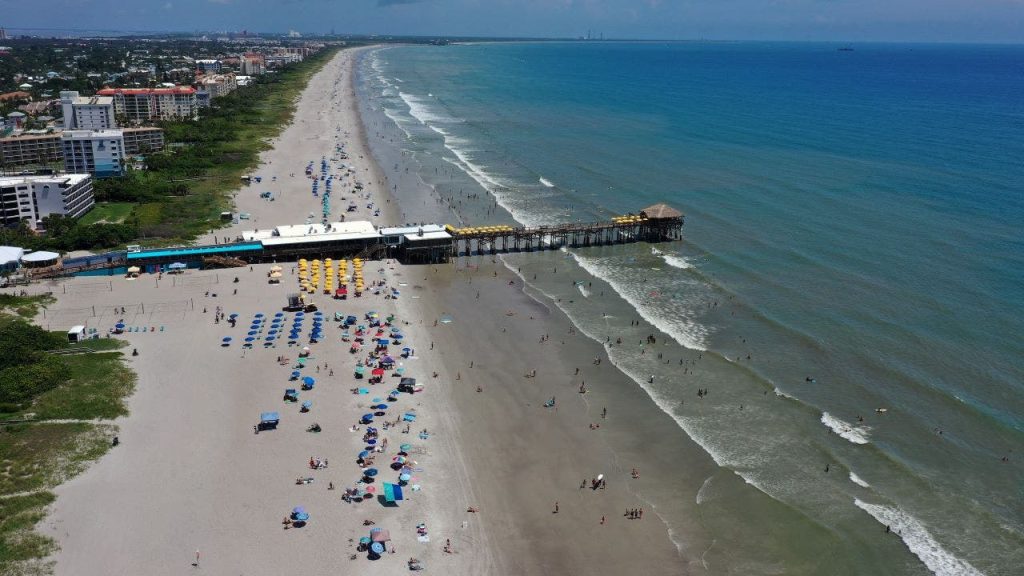Florida Beaches Top the List of Shark Attack Hotspots in the U.S.
A new report by weather forecasting company Tideschart has revealed that Florida beaches dominate the list of top U.S. locations for shark attacks, with data spanning from 1642 to 2024. The findings show that nine out of the ten beaches with the most recorded shark attacks are located in Florida, with New Smyrna Beach leading the pack with a staggering 277 incidents. This small stretch of coastline has earned the ominous nickname “shark bite capital of the world,” a title that was reinforced just recently when 40-year-old surfer Matthew Bender was bitten on the arm in July 2024. Bender described the sudden attack vividly, saying, “I felt it clamp down like a bear trap out of nowhere. By the time I looked down, it was already gone. I never saw the shark, but it bit really forcefully.” This incident serves as a stark reminder of the potential dangers lurking beneath the surface at some of America’s most popular beach destinations.
The comprehensive list compiled by Tideschart shows a clear concentration of shark activity along Florida’s coastline. Following New Smyrna Beach’s 277 attacks, Daytona Beach ranks second with 67 incidents, and Cocoa Beach comes in third with 39 recorded attacks. Myrtle Beach, South Carolina breaks Florida’s streak at the fourth position with 36 attacks, while Palm Beach rounds out the top five with 35 incidents. The remaining top spots are claimed by more Florida locations: Indialantic Boardwalk (30 attacks), Fort Pierce Inlet (24 attacks), Jupiter Beach Park (23 attacks), Riviera Beach (21 attacks), and Cape Canaveral (19 attacks). Tied with Cape Canaveral is another South Carolina location, Isle of Palms, also with 19 recorded attacks. Other coastal areas like Galveston, Texas; Monterey, California; and Gulf Shores Public Beach in Alabama appeared further down the list, highlighting the particular risk concentration in the Sunshine State.
Despite these alarming statistics, Ryan Blundell, founder of Tideschart, emphasizes that these findings shouldn’t cause panic or deter people from enjoying the ocean. “The concentration of shark attacks along Florida’s coastline is striking, with New Smyrna Beach in particular standing out as a global hotspot for shark encounters,” Blundell notes. “Many people are unaware that certain beaches pose significantly higher risks than others when it comes to shark activity.” He suggests that this information should instead promote awareness and encourage safer beach practices. “These statistics shouldn’t prevent people from enjoying the ocean, but they do highlight the importance of staying informed about local marine conditions and following safety guidelines when swimming or surfing in these areas. Understanding shark patterns and behaviors can help beachgoers make safer choices about where and when to enter the water.”
The Florida Fish and Wildlife Conservation Commission has issued several practical recommendations for swimmers concerned about shark encounters. One key piece of advice is to stay in groups when swimming, as sharks are more likely to approach lone individuals. The commission also advises against venturing too far from shore, which can isolate swimmers and make rescue more difficult in case of an emergency. Additionally, extra caution is urged when swimming in murky waters, where visibility is reduced and sharks might mistake humans for their natural prey. These simple precautions can significantly reduce the risk of shark encounters while still allowing beachgoers to enjoy Florida’s beautiful coastal waters. It’s worth noting that despite the seemingly high numbers of attacks over the centuries, shark incidents remain relatively rare when compared to the millions of swimmers who visit these beaches each year.
Understanding why Florida beaches, particularly New Smyrna Beach, experience so many shark encounters requires examining several factors. The region’s warm waters attract abundant marine life, creating a rich ecosystem that supports numerous shark species. New Smyrna Beach’s location near Ponce Inlet creates strong currents that bring baitfish close to shore, which in turn attracts predators like sharks. The beach is also extremely popular for surfing, with surfers often paddling in areas where sharks are actively feeding. The splashing and kicking motions of swimmers and surfers can resemble the movements of injured fish, potentially triggering a shark’s predatory instincts. Additionally, Florida’s coastline serves as a migratory route for several shark species, increasing the likelihood of human-shark interactions simply due to proximity. These environmental and behavioral factors combine to create conditions where shark encounters are more probable than at other coastal locations.
When putting these statistics into perspective, it’s important to recognize that the data spans nearly four centuries (1642-2024), and fatal shark attacks remain extremely rare. Most incidents result in relatively minor injuries, often described as “bite and release” encounters where the shark quickly realizes the human is not its intended prey. Experts emphasize that sharks do not hunt humans intentionally, and most attacks are cases of mistaken identity or exploratory bites. By comparison, everyday risks like drowning, car accidents, or even being struck by lightning pose far greater threats to beachgoers than shark attacks. Nevertheless, the concentration of incidents at certain beaches highlights the value of location-specific awareness and precautions. As climate change affects ocean temperatures and marine ecosystems, monitoring shark behaviors and attack patterns remains important for both conservation efforts and public safety. With proper education and reasonable precautions, visitors can continue to enjoy Florida’s beautiful beaches while minimizing their risk of an unwanted shark encounter.


